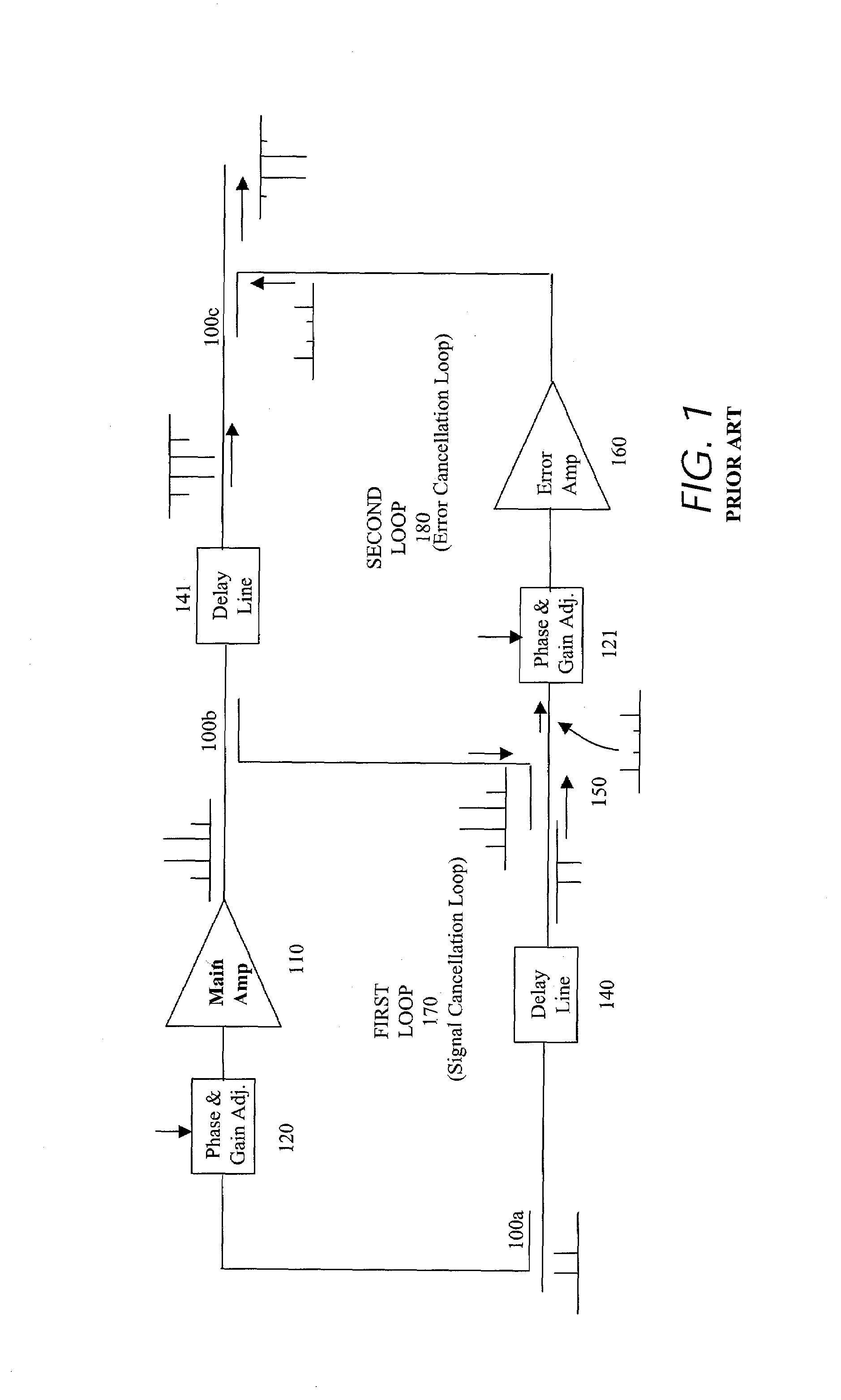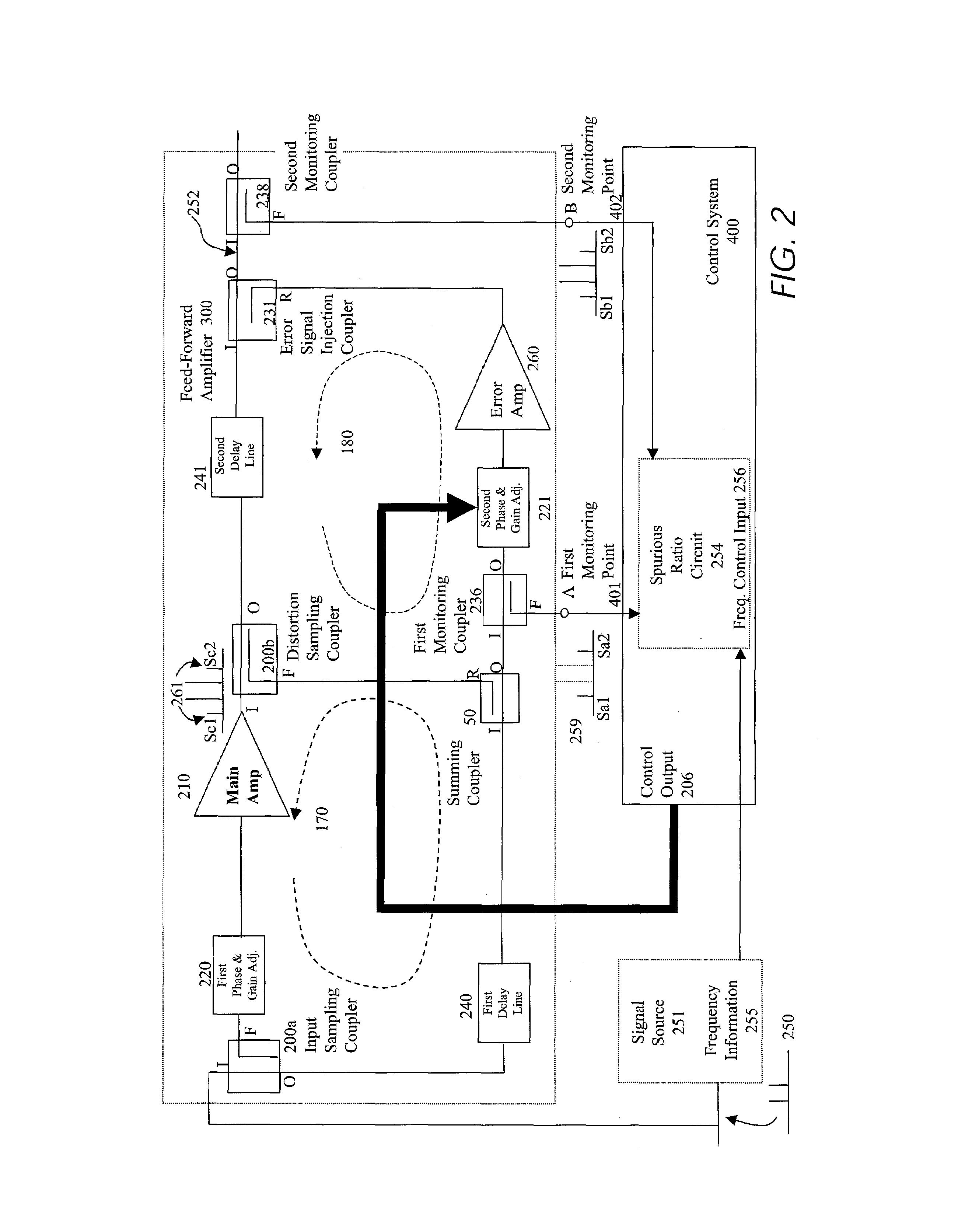Spurious ratio control circuit for use with feed-forward linear amplifiers
a technology of ratio control circuit and linear amplifier, which is applied in the direction of amplifier modification to reduce non-linear distortion, transmission, transmission monitoring, etc., can solve the problems of integer multiples of original carrier frequency sum and difference of spurious outputs, and achieve the effect of optimizing the adjustment of error-canceling loop and minimizing the ratio of the second spurious component to the first spurious componen
- Summary
- Abstract
- Description
- Claims
- Application Information
AI Technical Summary
Benefits of technology
Problems solved by technology
Method used
Image
Examples
first embodiment
[0035]FIG. 2 is a feed-forward amplifier system having a control system 400 including a spurious ratio circuit 256. The spurious ratio circuit 256 is coupled to a feed-forward amplifier 257, such as a feed-forward power amplifier, at two monitoring points. The feed-forward amplifier has two monitoring points at A and B. The control system 400 produces an output that is coupled to phase and gain adjustment circuits in the feed-forward amplifier. Frequency information derived from an input signal source 251 is coupled to the spurious detection circuit 254.
[0036]Prior knowledge of the frequencies being transmitted is utilized by the spurious detection circuit to measure distortion. In many communication systems such as cellular telephone systems, for example, the frequencies being amplified and subsequently transmitted are known. Transmitting frequency information is typically available from a bank of synthesizers, and is often available over a control bus. Exemplary control buses incl...
second embodiment
[0073]FIG. 6 is a block diagram of a feed-forward amplifier with a spurious ratio detector, including a switch to periodically sample monitoring points B and C (point A being monitored continuously). Where an adaptive predistorter 305 is included, the ratios A / C and B / A are measured. A first input of the spurious detector 254 is directly coupled to monitoring point A, a second input of the spurious detector 254 is coupled to the output of a switch 501. Monitoring point C is coupled to a first input of switch 501. Monitoring point B is coupled to a second input of switch 501. The switch 501 switches between C and B.
third embodiment
[0074]FIG. 7 is a block diagram of the feed-forward amplifier including a spurious ratio detector with a single receiver and a three way switch to periodically sample monitoring points A, B and C. This embodiment is used where the signal dynamics tend to be slow. It may be used in place of the two receiver design shown in the spurious detection circuit (254 of FIG. 5). A single receiver such as 430, 410 and 421 of FIG. 5 is used to form receiver 503. Sampling is achieved by switching the single receiver 503 between two or three of the monitor points A, B and C, and sequentially sampling the distortion power from each.
[0075]A single receiver 503 typically comprises a conventionally constructed mixer having a distortion signal coupled to a first input port, and a second input port coupled to an output port of a conventionally constructed local oscillator. A mixer output port is coupled to an input port of a conventionally constructed band pass filter. A band pass filter output is coup...
PUM
 Login to View More
Login to View More Abstract
Description
Claims
Application Information
 Login to View More
Login to View More - R&D
- Intellectual Property
- Life Sciences
- Materials
- Tech Scout
- Unparalleled Data Quality
- Higher Quality Content
- 60% Fewer Hallucinations
Browse by: Latest US Patents, China's latest patents, Technical Efficacy Thesaurus, Application Domain, Technology Topic, Popular Technical Reports.
© 2025 PatSnap. All rights reserved.Legal|Privacy policy|Modern Slavery Act Transparency Statement|Sitemap|About US| Contact US: help@patsnap.com



